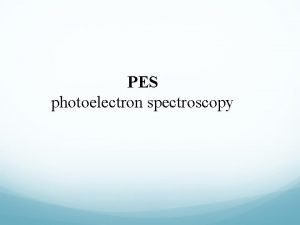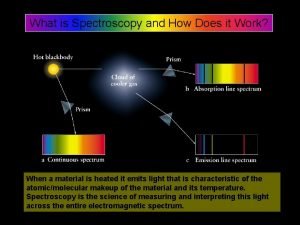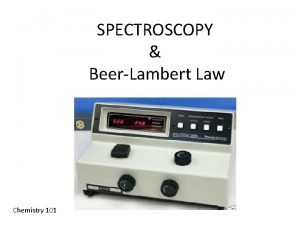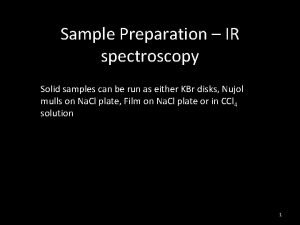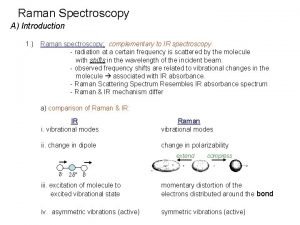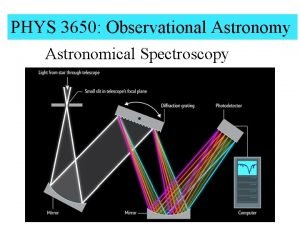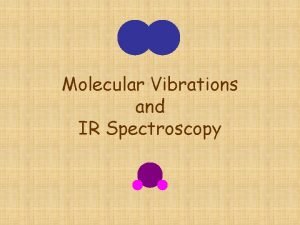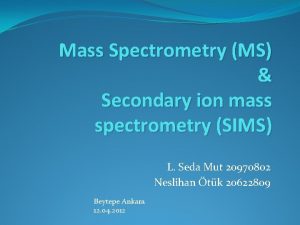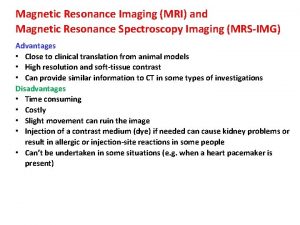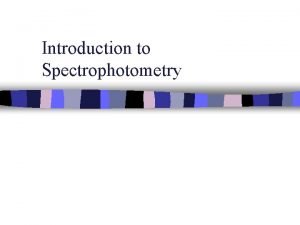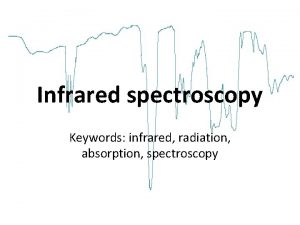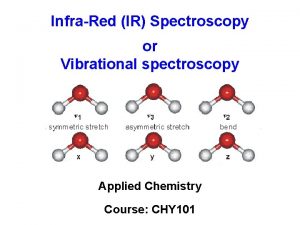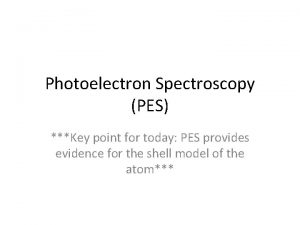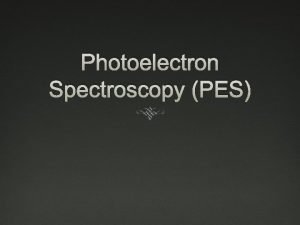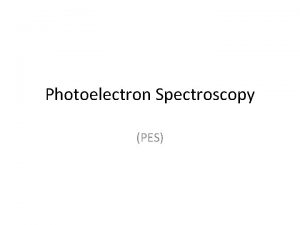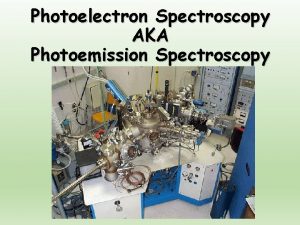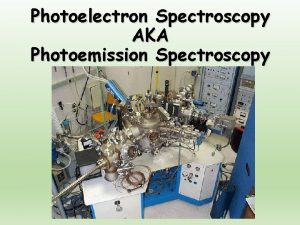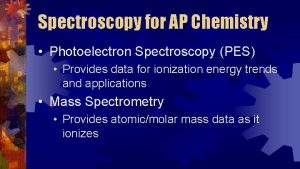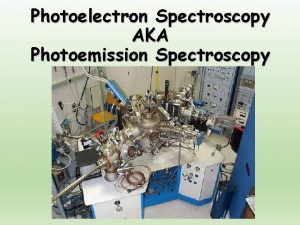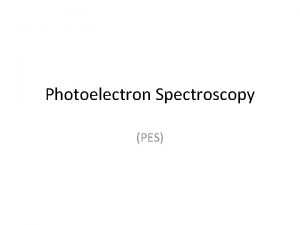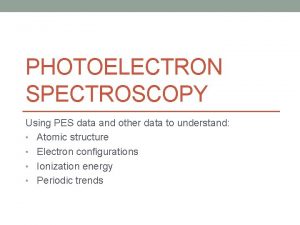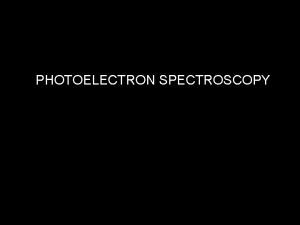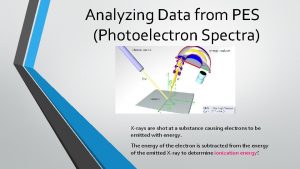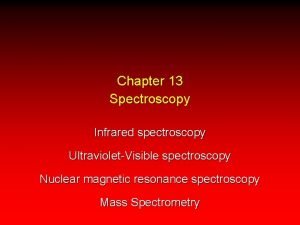PES photoelectron spectroscopy How does PES work PES





























- Slides: 29

PES photoelectron spectroscopy

How does PES work? PES works on the same principle as the photoelectric effect.

Photoelectric Effect of visible light http: //hyperphysics. phy-astr. gsu. edu/hbase/mod 1. html


• The photon has energy larger than the binding energy (Eb) of the atoms specific electron. • The photon typically used with PES is Uv light or x-ray. • The ejection of an electron produces a positive ion.

Ultraviolet Photoelectron Spectroscopy valence electrons core electrons Decreasing Binding Energy UV (hn) Ek = hn – Eb Eb = hn – Ek ejected valence electron (e-) Ek = kinetic energy Eb = binding energy

X-ray Photoelectron Spectroscopy valence electrons X-ray (hn) core electrons Decreasing Binding Energy Ek = hn – Eb Eb = hn – Ek ejected core electron (e-) Ek = kinetic energy Eb = binding energy

Useful Unit Conversions MJ = megajoule (this unit is a 1000 x greater than kilo)

• The excess energy is carried off by the electron ejected in the form of kinetic energy • The binding energy (energy required to remove this electron) from the atom is equal to the difference between the energy of the radiation absorbed by the atom (hv) and the Ek of the ejected photoelectrons. Eb = hv – Ek Absorbed energy from the photon KE of the ejected photoelectron

• The values of binding energy found reveal information about the elements present and the orbitals from which the electrons were ejected • Lower binding energies are seen for valence electrons, • higher binding energies are seen for core electrons • For molecules, correlation tables are available to identify the atomic composition of a molecule based on the binding energies of the photoelectrons observed

• For molecules, correlation tables are available to identify the atomic composition of a molecule based on the binding energies of the photoelectrons observed Skoog, Holler, Crouch, “Principles of Instrumental Analysis, ” 6 th Ed. p 593.

Data is obtained as peaks in a spectrum. Two common ways to label the x-axis • The spectrum can be plotted so that energy increases toward the left (typically) or right, on the x-axis. • Peak height is directly proportional to the number of electrons of equivalent energy ejected.

If you see two peaks with a relative height difference of 2: 1 the conclusion is the taller peak contains 2 x the number of electrons.

Hydrogen • has 1 peak in the PES scan above because it has 1 electron. (1 s 1) • The peak measures 1. 312 MJ/mol (1312 KJ/mol) • This is the energy required to eject the electrons from one mole of hydrogen atoms.

Helium • has one peak (1 s 2) • It is shifted to the left as compared to hydrogen’s peak. • The peak measures 2. 372 MJ/mol • It takes more energy to remove an electron in the He atom vs H atom. • The peak is 2 x that of hydrogen …. . consistent with 2 e- in He • (both H and He have electrons in n=1)

Lithium • has 2 peaks (1 s 2 2 s 1) • The smaller peak represents the 2 s 1 electron. It requires 0. 52 MJ/mole to remove one mole of electrons. • The larger peak represents the 1 s 2 core electrons. It is twice the size as the smaller peak (correlating with the concept that twice the peak size, twice the number of electrons). Both electrons require 6. 26 MJ/mol energy to be released. Energy is not represented by the peak size. It relates to the electron location within the atom. These electrons are closer to the nucleus (core electrons)

Beryllium • has 2 peaks (1 s 2 2 s 2) • 1: 1 ratio both are of similar size • The peak to the right is of lesser energy 0. 90 MJ/mol(valence shell electrons n=2) compared to the inner peak measuring 11. 5 MJ/mol (core electrons n=1). Once again the peaks are similar in size (both contain two electrons). But the energy varies due to location within the atom.

Boron 2: 1 ratio of electrons n=1 n=2

PES summary • PES determines the energy needed to eject electrons Which is called the binding energy (ionization energy). • The PES data reinforces the shell model of the atom and infers the electronic structure of atoms. • PES scans support the idea that electrons in n=2 occupy different subshells (s, p), n=3 (s, p, d) and n=4 (s, p, d, f)

• The peaks in n=1 and n=2 (He and Be respectively) are similar in size proving 2 electrons are present in the two different PELS. The difference in binding energy is a function of nuclear charge. • It takes more energy to remove an electron from n=2 than n=3. And even more energy from n=1. • Within any subshell it always takes the most energy to remove an electron from the s subshell.

So our expectation. It takes more energy to remove an electron from n=2 than n=3. And even more energy from n=1 Q: Do all electrons in a given shell have the same energy? A: No…Electrons within a specific sublevel (s, p, d, f) have similar energies.

Useful Web Sites Simulated photoelectron spectra for some common elements • http: //www. chem. arizona. edu/chemt/Flash/photoelectron. html A complimentary lesson on PES • http: //www. bozemanscience. com/apchem-004 -coulombs-law/

Sulfur 2 p Binding Energies Skoog, Holler, Crouch, “Principles of Instrumental Analysis, ” 6 th Ed. p 597.

Label the sublevels





 Draw a photoelectron spectrum for aluminum
Draw a photoelectron spectrum for aluminum Photoelectron spectroscopy ap chemistry
Photoelectron spectroscopy ap chemistry Magnesium pes spectrum
Magnesium pes spectrum Xps instrument
Xps instrument How does pes work
How does pes work What is spectroscopy
What is spectroscopy Auxochrome
Auxochrome Terahertz spectroscopy principles and applications
Terahertz spectroscopy principles and applications Advantages and disadvantages of spectroscopy
Advantages and disadvantages of spectroscopy Beer's law explained
Beer's law explained Kbr sample preparation
Kbr sample preparation Prinsip aas adalah
Prinsip aas adalah Why are raman and ir complementary
Why are raman and ir complementary Difference between ir and raman spectroscopy
Difference between ir and raman spectroscopy Advantages and disadvantages of spectroscopy
Advantages and disadvantages of spectroscopy Objectives of spectroscopy
Objectives of spectroscopy Nir spectroscopy instrumentation
Nir spectroscopy instrumentation Stretching and bending vibrations in ir spectroscopy
Stretching and bending vibrations in ir spectroscopy Secondary ion mass spectroscopy
Secondary ion mass spectroscopy Advantages and disadvantages of spectroscopy
Advantages and disadvantages of spectroscopy Gross selection rules
Gross selection rules Spectroscopy and spectrophotometry
Spectroscopy and spectrophotometry Dept nmr spectroscopy
Dept nmr spectroscopy Applications of uv visible spectroscopy
Applications of uv visible spectroscopy Raman spectroscopy basics
Raman spectroscopy basics Ortec renaissance software
Ortec renaissance software Spectroscopy infrared
Spectroscopy infrared Periklis papadopoulos
Periklis papadopoulos Is spectroscopy
Is spectroscopy Nitro group ir peak
Nitro group ir peak




